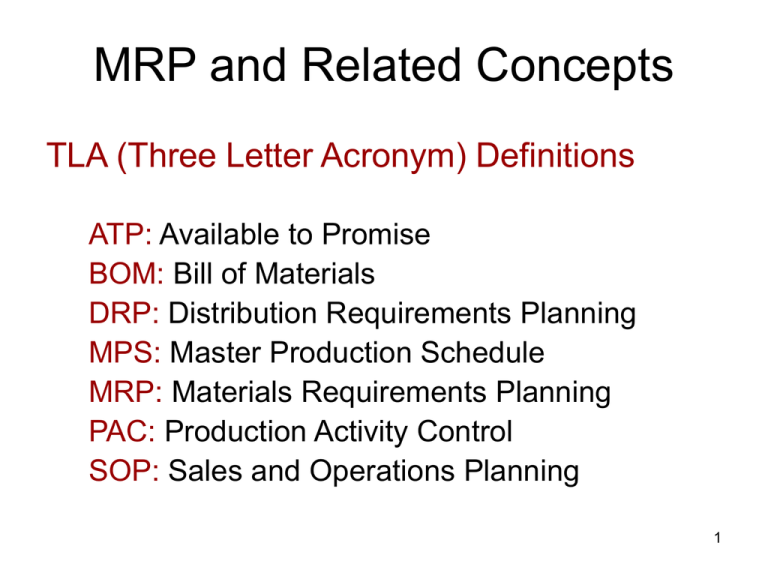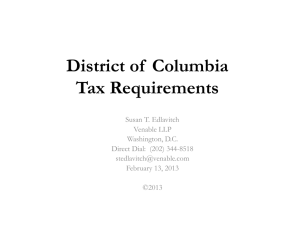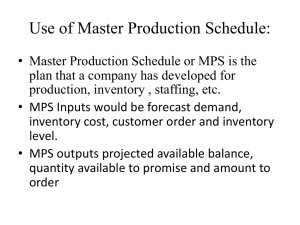Material Requirements Planning
advertisement

MRP and Related Concepts TLA (Three Letter Acronym) Definitions ATP: Available to Promise BOM: Bill of Materials DRP: Distribution Requirements Planning MPS: Master Production Schedule MRP: Materials Requirements Planning PAC: Production Activity Control SOP: Sales and Operations Planning 1 Where Does MRP Fit? PAC SOP Tactical Capacity Planning MPS Production, Order Fulfillment, Cushions MRP Material Quantities and Timing Vendor Order Managment Supply Chain Management and PDCA Production Management and PDCA 2 Master Scheduling I • Controls the timing and quantity of production for products or product families • Primary interface point for actual customer orders • Coordinates forecasted demand and actual orders with production activity • Serves as tool for agreement between marketing and operations (but at a different level than SOP) 3 Master Scheduling II • Feeds more detailed material planning • Indicates the quantity and timing (i.e., delivery times) for a product or group of products • More detailed than SOP weekly versus monthly specific products versus “average” must satisfy the needs of marketing must be feasible for operations 4 Link between SOP and MPS Month: Output: January 200 February 300 March 400 January (weeks) 1 2 3 4 Push Mowers Self-propelled Riding 25 25 35 25 25 40 12 SOP MPS 13 5 MPS Formulas: Definitions • ATPt = Available to promise in period t • EIt = Ending Inventory for period t (same as projected on-hand inventory for next period) • Ft = Forecasted demand for period t • MPSt = MPS quantity available in period t • OBt = orders booked for period t 6 MPS Formulas: EI t EI t 1 MPSt max( Ft , OBt ) z 1 ATPt EI t 1 MPSt OBi i t where z period when next positive MPSt is due 7 Detailed MPS for Widgets On-hand inventory at end of October = Month Week 100 November December 45 46 47 48 49 50 51 52 Forecast Demand 150 150 150 150 125 125 125 125 Orders Booked 170 165 140 120 85 45 20 0 Master Schedule 300 0 300 0 250 0 250 0 Notes: Planning time fence cumulative lead time for product What seems to be the lot-sizing rule here? 8 Projected On-Hand Inventory On-hand inventory at end of October = Month Week 100 November December 45 46 47 48 49 50 51 52 Forecast Demand 150 150 150 150 125 125 125 125 Orders Booked 170 165 140 120 85 45 20 0 Projected On-Hand Inventory 230 65 215 65 190 65 190 65 Master Schedule 300 0 300 0 250 0 250 0 i.e. Projected on-hand inventory for week 47: = 65 + 300 – 150 = 215 9 Available-to-Promise On-hand inventory at end of October = Month Week 100 November December 45 46 47 48 49 50 51 52 Forecast Demand 150 150 150 150 125 125 125 125 Orders Booked 170 165 140 120 85 45 20 0 Projected On-Hand Inventory 230 65 215 65 190 65 190 65 Master schedule 300 0 300 0 250 0 250 0 Available-to-Promise 65 40 120 70 230 ATP(45) = 100 + 300 – (170 + 165) = 65 ATP(47) = 300 – (140+120) = 40 ATP(49) = 250 – (85 + 45) = 120 10 Change in Forecast Demand On-hand inventory at end of October = Month Week 100 November December 45 46 47 48 49 50 51 52 Forecast Demand 150 150 150 150 150 150 150 150 Orders Booked 170 165 140 120 85 45 20 0 Projected On-Hand Inventory 230 65 215 65 165 15 115 (35) Master schedule 300 0 300 0 250 0 250 0 Available-to-Promise 65 40 120 230 Are we in trouble yet? 11 Change in Orders Booked On-hand inventory at end of October = Month Week 100 November December 45 46 47 48 49 50 51 52 Forecast Demand 150 150 150 150 125 125 125 125 Orders Booked 170 230 140 120 85 45 20 0 Projected On-Hand Inventory 230 0 150 0 125 0 125 0 Master schedule 300 0 300 0 250 0 250 0 Available-to-Promise 0 40 120 230 Note impact of ATP(45) and on-hand inventory projections 12 Key Points about MPS • Provides more detail than SOP • Tracks the following information: – Actual versus forecasted demand – Available-to-Promise • This gives sales information for accepting or not accepting new orders for delivery in a given week 13 A Final View of Master Scheduling SOP Marketing Operations MPS Rough-Cut Capacity Plan 14 Material Requirements Planning • MRP in the planning cycle • The logic of MRP – an extended example • Considerations of MRP 15 Assume that we’ve scheduled 500 chairs to be ready five weeks from now. . . . Now what? 16 Material Needed for a Chair Side rails (2) Seat Front legs (2) Cross bars (2) Back supports (3) 17 Chair Structure Tree (aka “Bill of Materials”) Chair Leg Assembly Legs (2) Cross bar Seat Side rails (2) Back Assembly Cross bar Back Supports (3) 18 Graphic Lead-Time Week 1 Week 2 Week 3 Week 4 Week 5 Back Support (2 weeks) Side Rails (2 weeks) Cross Bar (2 weeks) Back Assembly (1 week) Seats (2 weeks) Legs (2 weeks) Leg Assembly Cross Bar (2 weeks) (1 week) Chair Assembly (1 week) 19 Lead-Time Key Points • To have finished chairs at the beginning of Week 5, we must begin production and order materials in Week 1. • “Exploding” the bill of materials tells us when to order things. • Not much we can do to adjust output of chairs for the next 4 weeks. Why? 20 Material Requirements Planning (MRP) We need the following inputs: 1. Bill-of-Materials (BOM) 2. Inventory records 3. Master production schedule We’ll get the following outputs: 1. What items should be ordered 2. When each item should be ordered 3. How much of each should be ordered 21 The MRP Process Starts with the MPS Chairs MPS Due Date Start Assembly Lead Time = 1 week Week 1 2 3 4 5 0 0 0 0 500 0 0 0 500 400 6 400 400 7 400 0 End items are also known as “Level 0” items 22 The “Parent / Child” Relationship Chairs LT = 1 week 2 0 0 Week 3 4 0 0 0 500 5 500 400 6 400 400 7 400 0 1 0 2 0 Week 3 4 0 500 5 400 6 400 7 0 0 0 0 0 400 400 0 400 400 0 500 400 1 0 0 MPS Due Date Start Assembly Seat LT = 2 weeks Minimum Order = 1 Gross Requirements Scheduled Receipts Projected On Hand Net Requirements Planned Receipts Planned Order 0 0 500 500 400 Where do the gross requirements come from? Do you understand the MRP logic? 23 Chairs LT = 1 week MPS Due Date Start Assembly 1 0 0 2 0 0 3 0 0 Week 4 0 500 5 500 400 6 400 400 7 400 0 1 0 2 0 3 0 Week 4 500 5 400 6 400 7 0 0 0 0 0 400 400 0 400 400 0 500 400 5 400 6 400 7 0 125 725 275 1000 725 5 400 6 400 7 0 100 400 500 500 200 300 500 200 Seat Going Deeper… LT = 2 weeks Minimum Order = 1 Gross Requirements Scheduled Receipts Projected On Hand Net Requirements Planned Receipts Planned Order 0 0 500 500 400 Leg Assembly LT = 1 week Minimum Order = 1000 Gross Requirements Scheduled Receipts Projected On Hand Net Requirements Planned Receipts Planned Order 25 1 0 2 0 25 0 25 0 Week 3 4 0 500 25 0 525 475 1000 1000 1000 Back Assembly LT = 1 week Minimum Order = 250 Gross Requirements Scheduled Receipts Projected On Hand Net Requirements Planned Receipts Planned Order 1 0 0 0 2 0 250 250 Week 3 4 0 500 250 250 0 250 250 500 Moving from “Level 1” items to “Level 2” items . . . Leg Assembly LT = 1 week Minimum Order = 1000 Gross Requirements Scheduled Receipts Projected On Hand Net Requirements Planned Receipts Planned Order 1 0 25 2 0 Week 3 4 0 500 5 400 6 400 7 0 125 725 275 1000 725 1 0 Week 2 3 4 5 0 2000 0 2000 6 0 7 0 0 0 0 0 25 0 25 0 25 0 525 475 1000 1000 1000 Legs LT = 2 weeks Minimum Order = 1 Gross Requirements Scheduled Receipts Projected On Hand Net Requirements Planned Receipts Planned Order 0 2000 0 2000 2000 2000 0 0 2000 2000 Where do the gross requirements for LEGS come from? 25 Combining Requirements: “Cross Bars” Leg Assembly LT = 1 week Minimum Order = 1000 Gross Requirements Scheduled Receipts Projected On Hand Net Requirements Planned Receipts Planned Order 25 1 0 2 0 25 0 25 0 Week 3 4 0 500 25 0 525 475 1000 1000 5 400 6 400 7 0 125 725 275 1000 725 1000 Back Assembly LT = 1 week Minimum Order = 250 Gross Requirements Scheduled Receipts Projected On Hand Net Requirements Planned Receipts Planned Order 1 0 0 0 2 0 250 250 3 0 0 250 Week 4 500 5 400 6 400 7 0 0 250 250 500 100 400 500 500 200 300 500 200 6 0 7 0 0 0 Crossbars LT = 2 weeks Minimum Order = 1 Gross Requirements Scheduled Receipts Projected On Hand Net Requirements Planned Receipts Planned Order 0 1 0 2 3 0 1250 0 0 1250 0 1250 1250 500 1500 Week 4 5 500 1500 0 0 500 1500 500 1500 Note effect of differences in lead times and order sizes on the gross requirements for each component 26 Impact of Longer Lead Times Leg Assembly We cannot do this since the planned order would be in the past…. Thus the 250 crossbars will be delivered late one week to back assembly. What does this do to our chair schedule? LT = 1 week Minimum Order = 1000 Gross Requirements Scheduled Receipts Projected On Hand Net Requirements Planned Receipts Planned Order 25 1 0 2 0 3 0 250 250 250 Week 4 500 5 400 6 400 7 0 125 725 275 1000 725 5 400 6 400 7 0 100 400 500 200 300 500 200 Week 4 5 500 1000 6 0 7 0 0 0 525 475 1000 1000 1000 Back Assembly LT = 2 weeks Minimum Order = 250 Gross Requirements Scheduled Receipts Projected On Hand Net Requirements Planned Receipts Planned Order 1 0 0 0 2 0 250 250 3 0 250 500 0 Week 4 500 0 250 250 500 Crossbars LT = 2 weeks Minimum Order = 1 Gross Requirements Scheduled Receipts Projected On Hand Net Requirements Planned Receipts Planned Order 0 1 0 2 3 250 1500 0 0 0 250 1500 250 1500 500 1000 250 1500 0 0 500 1500 500 1500 27 Do You Understand ... • Why it is important to have an accurate BOM and accurate inventory information? • Why do we need to “freeze” production schedules? • Where do gross requirements come from? • The is the difference between planned and scheduled receipts? 28 Other Considerations I MRP Feedback Feedback Planned Orders Production Suppliers 29 Other Considerations II • When do we update the system? • Capacity requirements planning using MRP output • “Pegging” • Lot sizing issues 30 Recall ... Leg Assembly LT = 1 week Minimum Order = 1000 Gross Requirements Scheduled Receipts Projected On Hand Net Requirements Planned Receipts Planned Order 25 1 0 2 0 250 250 Week 3 4 0 500 5 400 6 400 7 0 125 725 275 1000 725 1 0 Week 2 3 4 5 0 2000 0 2000 6 0 7 0 0 0 0 0 250 525 475 1000 1000 1000 Legs LT = 2 weeks Minimum Order = 1 Gross Requirements Scheduled Receipts Projected On Hand Net Requirements Planned Receipts Planned Order 0 2000 0 2000 2000 2000 0 0 2000 2000 Look at the “lumpiness” of demand for legs 31 If we order “lot-for-lot” Leg Assembly LT = 1 week Minimum Order = 1 Gross Requirements Scheduled Receipts Projected On Hand Net Requirements Planned Receipts Planned Order 25 1 0 2 0 250 250 Week 3 4 0 500 5 400 6 400 7 0 0 475 475 400 0 400 400 400 0 400 400 0 Week 3 4 950 800 5 800 6 0 7 0 0 800 800 0 0 250 475 Legs LT = 2 weeks Minimum Order = 1 Gross Requirements Scheduled Receipts Projected On Hand Net Requirements Planned Receipts Planned Order 0 1 0 2 0 0 0 950 800 0 950 950 800 0 800 800 Much smoother demand for legs, lower average inventory 32 Distribution Requirements Planning (DRP) • Anticipates downstream demand – Uses this information, not predetermined reorder points or periodic reviews, to determine when to order • Computer-based software systems needed to deal with the added complexity 33 DRP Example I Wholesaler A ROP = 50, Q = 200 Forecast Demand Ending Inventory Expected Order Day 1 Day 2 Day 3 Day 4 Day 5 Day 6 Day 7 Day 8 20 20 20 20 20 20 20 20 85 65 45 225 205 185 165 145 125 200 Suppose we forecast demand for Wholesaler A for the next 8 days (the best time horizon to use will depend on many factors) Based on this, we anticipate that Wholesaler A will order on Day 3 34 DRP Example II Wholesaler A ROP = 50, Q = 200 Forecast Demand Ending Inventory Expected Order Day 1 Day 2 Day 3 Day 4 Day 5 Day 6 Day 7 Day 8 20 20 20 20 20 20 20 20 85 65 45 225 205 185 165 145 125 200 Wholesaler B ROP = 75, Q = 200 Forecast Demand Ending Inventory Expected Order Total Orders Day 1 Day 2 Day 3 Day 4 Day 5 Day 6 Day 7 Day 8 14 14 14 14 14 14 14 14 108 94 80 66 252 238 224 210 196 200 200 200 We extend the analysis to include Wholesaler B Combined, we expect to see orders on Days 3 and 4 35 DRP Example III Wholesaler A ROP = 50, Q = 200 Forecast Demand Ending Inventory Expected Order Day 1 Day 2 Day 3 Day 4 Day 5 Day 6 Day 7 Day 8 20 20 20 20 20 20 20 20 85 65 45 225 205 185 165 145 125 200 Wholesaler B ROP = 75, Q = 200 Forecast Demand Ending Inventory Expected Order Day 1 Day 2 Day 3 Day 4 Day 5 Day 6 Day 7 Day 8 14 14 14 14 14 14 14 14 108 94 80 66 252 238 224 210 196 200 Distributor Q = 400 Total Expected Orders Ending Inventory Planned Receipts Planned Orders Day 1 Day 2 Day 3 Day 4 Day 5 Day 6 Day 7 Day 8 200 200 50 50 50 250 50 50 50 50 50 400 400 The distributor then uses this information to plan its own orders. In this case, suppose it takes two days for the supplier to replenish; based on the information, the distributor would order on Day 1 36 DRP Benefits Helps improve customer service Provides a better and faster understanding of the impact of shortages and/or promotions Helps reduce costs Inventory Freight Production Provides integration between the stages in the supply chain 37 DRP Constraints • Accurate forecasts and inventory levels – Necessary to anticipate correctly when orders will be placed • Consistent and reliable lead times – To ensure that orders can be placed and arrive by the time they are needed • “Nervousness” – Even slight changes in demand for downstream partners can have a significant impact on order volumes, especially when order sizes are relatively high 38






